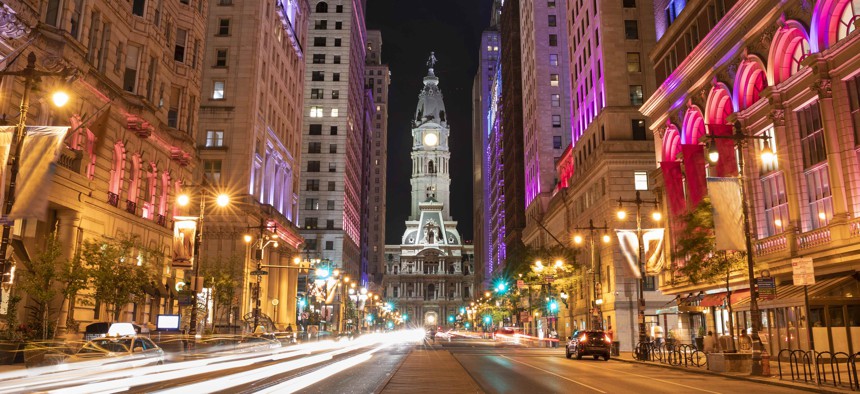Infrastructure Tops Mayors’ Concerns for 2nd Year

Philadelphia's City Hall at night Pgiam via Getty Images
The National League of Cities’ analysis of local leaders’ speeches finds renewed interest in maintenance and construction projects, and worries about how they will handle billions in new federal dollars.
Infrastructure topped the list of concerns from mayors and other city leaders for the second straight year, according to an analysis of “state of the city” addresses released Wednesday.
The renewed interest in infrastructure comes as local governments prepare to apply for and manage billions of dollars of new federal money being distributed as a result of the Infrastructure Investment and Jobs Act, which President Biden signed late last year. The opportunity gives city leaders a chance to take care of long-neglected facilities and to imagine new projects.
More than a third of mayors discussed their infrastructure plans at length during their annual speeches, according to a National League of Cities analysis of 60 speeches delivered between October 2021 and April 2022.
“Cities are investing capital funds in a wide range of both maintenance and construction
projects, including parks and recreation facilities, broadband and fiber optic equipment and systems, roads and bridges, bike trails and pedestrian infrastructure, water and sewer systems, transportation, water treatment and reclamation and public transit,” the NLC wrote in its annual “State of the Cities” report.
For example, cities such as Aiken, South Carolina, and Fargo, North Dakota, are building new water treatment plants. Fargo Mayor Timothy Mahoney also described progress in an effort to connect his city to water sources 170 miles to the west, in order to protect against drought-related shortages.
Meanwhile, the mayor of Charleston, West Virginia, discussed reviving the city’s waterfront, while Mayor Bill Droste of Rosemount, Minnesota, outlined potential railroad overpass projects.
Re-energizing and Redeveloping
Also near the top of mayors’ agendas was economic development.
At a time when the national economy faces headwinds such as high inflation and widespread worker shortages, local leaders emphasized tangible benefits to their communities. Those included plans to re-energize downtown areas or redevelop key properties, at a time when many cities are trying to lure white collar workers out of their home offices and into downtown office buildings.
Mayor Matt Murphy of Valparaiso, Indiana, for example, envisioned the redevelopment of a vacant factory into a new destination called the Barrel District that would include a brewery, distillery restaurant and event space. It would include transit and a walking trail connecting it to downtown.
City leaders also shared plans to address the economic hardships faced by many of their residents. Mayor Sue Himmelrich of Santa Monica, California, discussed plans to build a food pantry to serve 200 families a week, as well as fund a grant program to support small businesses.
Nearly a quarter of mayors made budget concerns a central focus of their addresses, but those worries often had to do with finding and handling new federal money, rather than a shortage of funds. Localities benefitted from federal subsidies in the 2021 American Rescue Plan Act, which alleviated many of their short-term budget fears at the height of the pandemic.
But finding qualified employees to deliver city services continues to be a problem.
“Like other sectors, cities are experiencing high turnover right now, with many announcing the departure or arrival of directors and leaders in the city. Municipal governments are experiencing labor loss at an even higher rate than other sectors, with a 4.48% loss in labor from March 2020 [to] March 2022. To recruit and retain employees, cities are increasing pay and other benefits in many departments,” the NLC wrote in its report.
It noted that mayors from cities around the country were looking at salary increases and hiring incentives to shore up the government workforce. Executives from Kingston, New York; Helena, Montana; Fayetteville, North Carolina; and Detroit were among those calling for better incentives.
Less than one in five mayors devoted a substantial amount of their speeches to public safety, with many of them talking about the need to build better relationships between communities and their police departments.
Mayors touched on other policy areas, as well, including health and human services, housing, technology, energy and the environment, demographics and education. But they tended not to linger very long on those topics.
For more information from the report click here.
Daniel C. Vock is a senior reporter for Route Fifty based in Washington, D.C.
NEXT STORY: Here's What the Gun Safety Deal Would Mean for States






